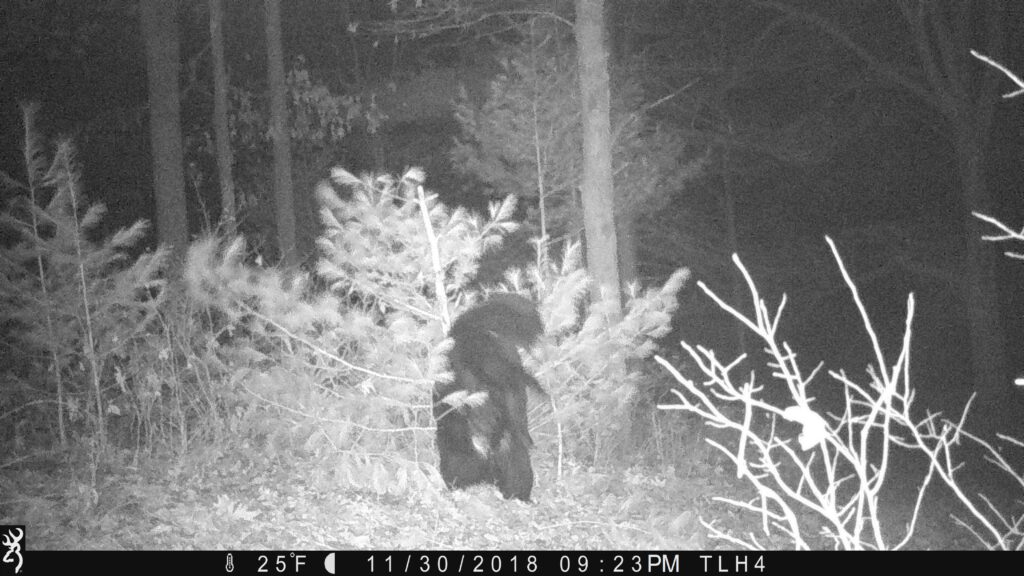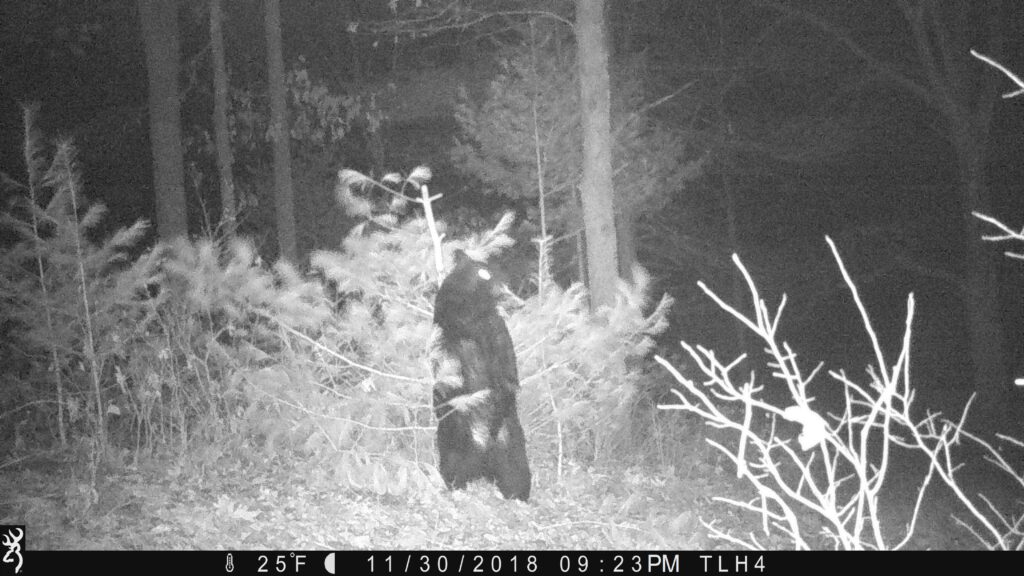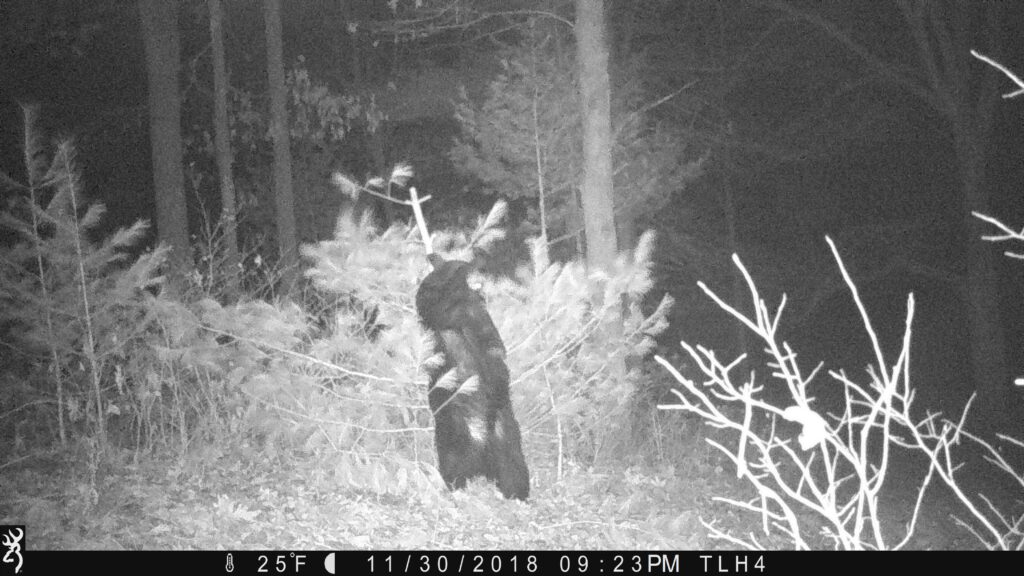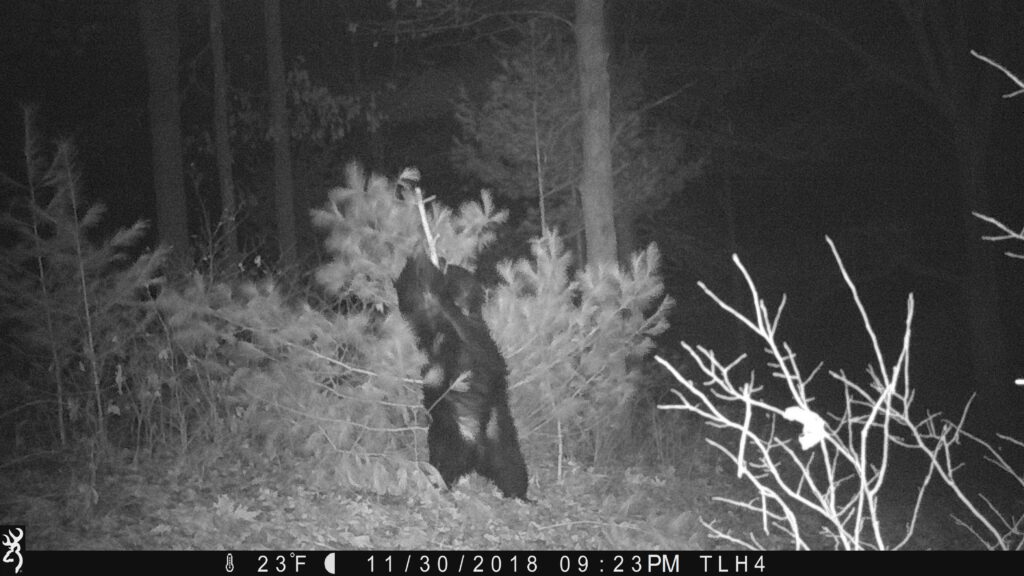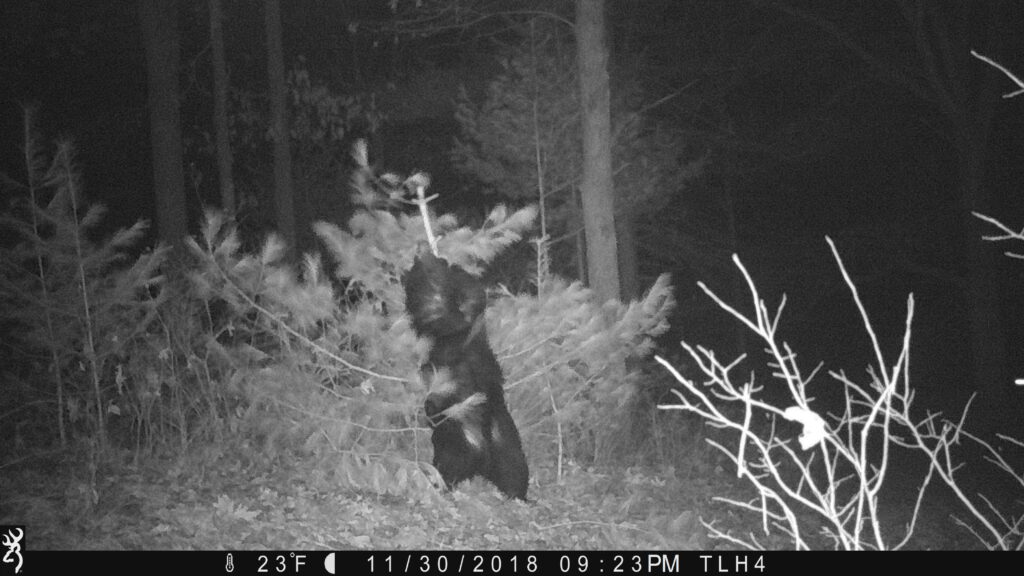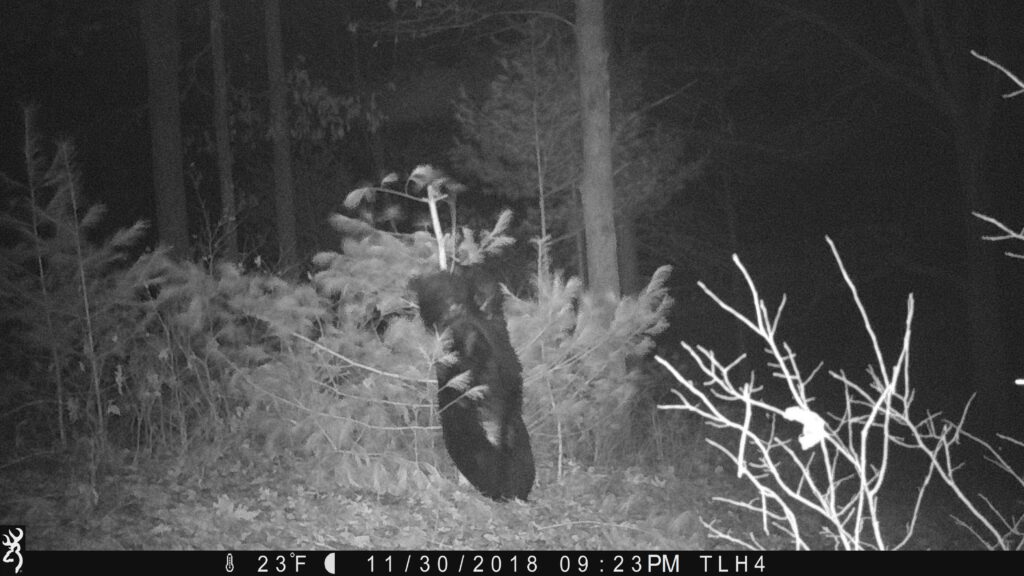Posts Tagged → drive
Ok so how is your deer season going?
You wait all year for these two weeks of rifle season in PA, and then after a restless night the opening morning arrives. Five days in, and hardly a shot heard each day, no deer seen, hardly any sign encountered, and you are wondering what the heck is going on.
Don’t sweat it, you are not alone. You are in very good company. A lot of Pennsylvania hunters are grousing to each other tonight about not seeing any let alone many deer so far, not getting shots at deer, not even finding sign of deer, like poop or tree rubs. Not even hearing shots. Apparently Wisconsin is also seeing a real drop in their deer harvest in firearms season, too.
Something is amiss, especially in the Big Woods, no question.
Are we witnessing some mass die-off from disease, like Chronic Wasting Disease, or Epizootic Hemorrhagic Disease? It is possible, but I have not yet seen any deer skeletons lying randomly in the woods. Maybe they are out there and I just haven’t found the graveyard yet. In 2005 northcentral PA had a huge deer die-off from late season snow and ice that made the mountains impassible. The deer could neither walk on the surface for weeks, nor could they dig through the compacted ice and snow to reach food. We did encounter random deer carcasses everywhere during the spring that year.
Maybe black bears ate more deer fawns than we anticipated (I witnessed a large black bear catching, killing, and eating a young deer this May, which is cool). Same can be surmised for coyotes, which are renowned deer eaters. After several years of purposefully hard harvests, there are now fewer bears in PA, by design, and theoretically less bear depredation of fawns in 2023. But there does seem to be an awful lot of coyotes. Everywhere.
Up north, we have no acorns to speak of. Late spring frosts killed our acorn flowers a couple years in a row, and gypsy moths have been terrible year after year. Any acorn flowers that survived spring frosts were eaten by the gypsy moths, whose egg masses are visible everywhere up here. So there is very little to no food in the Big Woods, and as a result, most wild animals seem to have flown the coop. Bear hunting last week was impossible. And so far this week, deer hunting has been tough.
Yesterday I was fortunate to set up in a natural funnel and catch two does transitioning from feeding areas to bedding areas. And today, with the help of friends on a small and carefully targeted drive, I filled my buck tag. Based on what I am hearing, I am incredibly lucky this year. Most hunters are struggling just to see deer tails bouncing off into the distance.
So if you are one of the PA hunters who is feeling dispirited right now about the apparent evaporation of deer this season, here is my best advice: Go hunt places you don’t normally hunt, and where you think others probably don’t hunt often, either. Steep hillsides are great locations for hiding deer. Play the wind, keeping it in your face as much as possible. Go slow, and quiet. And have a friend or two join you for a two-man push or leap-frog, or a two-man push with one stander. And then the stander becomes a pusher and the former pushers take up stands.
Remember that whitetails like to loop around behind their pursuers. If one guy is pushing and another guy is quietly lagging behind a hundred yards or more, he has a good chance of getting the deer that snuck off and went around the pusher. Again, make sure the wind is in your favor (blowing from the deer to you, not from you to the deer), and be as quiet as possible.
Switch up your game this season, because it seems that just sitting and waiting for animals to come out and present themselves broadside is not happening a whole lot in 2023. We gotta get in after them, and make our own action.
Good luck!
Yeah, PA’s lame bear season in one picture
Pennsylvania is about to have one of its lowest bear harvests in decades. And like so many policies of any sort, the story of this failure is told not just by the data, but by a picture of the data (see below).
In sum, this year’s early bear seasons of archery and muzzleloader resulted in roughly 1200 bears being taken by hunters. These are predominantly individual hunters in elevated stands, not crews of drivers pushing bears to standers.
By the time the real firearms “bear season” arrives in late November, much of the steam has been bled out of the system, so to speak. The demand has been met. Many serious bear hunters have already taken their bear and they won’t be going “to camp” to participate in punishing bear drives through thick mountain laurel on steep mountains in the northcentral region. And when the most ardent hunters pull out of a camp, that loss of energy and excitement affects everyone else. We noticed many empty camps across the entire northern tier this past week.
Again, the 1,217 bears taken in the early season so far are 200 bears ahead of the roughly 1,000 bears on record for the “bear season” as of tonight, which is the end of the formal “bear season.” In other words, bear season wasn’t. It is actually producing behind the early season.
So is the early season the real bear season now?
Add a poor acorn crop to the situation, and whatever bears were roaming around in October’s early season have gone to den for the winter now in our “bear season,” or have moved southward by the time November arrives, because all of the available wild food has been eaten up. We are now in our third year of a failed acorn crop in the northern tier, and the silence of our woods shows it. No food means no wildlife. Hunters saw no poop, no deer rubs, no squirrels, no nothing. Hunters scouring rugged northern tier landscapes that are the historic high producers of bears are encountering woods devoid not just of bears, but of deer and turkey, as well.
Yesterday was a classic example of this dynamic. Our guys put on a drive across a NW Lycoming County mountaintop area that usually holds bears. I was the lone stander in the primo spot, a saddle between two hills with a stream running through. I could see far in every direction. There were no other drives happening anywhere around our guys, which is unusual. But another and much larger drive was going on behind me, and pushing toward the area we had hunted the day before. And half a mile down the forest road several long range hunters were set up looking across a canyon. If there were bears around, or even deer, the two drives would push them past the long range guys, at least.
And yet, by the time dusk arrived and our men had slid and tumbled down the mountain side to gather at the truck, no one anywhere had seen a bear or a deer, nor heard a shot. The long range guys were packing up as we were driving out, and they told us they had seen several deer on Sunday, but nothing else any other day, including that day that had so much activity.
The Pennsylvania Game Commission is a government agency, and agencies make mistakes. Sometimes the best-intended and carefully considered policies have unintended consequences. Maybe the Saturday opener (as opposed to the long-time Monday opener) to bear season is part of the failure we are seeing. Maybe it’s the acorn crop failure making a bad situation worse. Maybe it’s the early season stealing all of the thunder from the regular rifle bear season. I don’t know the entire answer why, but the numbers don’t lie, and this 2023 bear season was a flop. Yes, we will see another 100-200 bears taken in the extended season that is concurrent with deer season in some Wildlife Management Units. But overall, PA has not seen a bear harvest this low in a long time. And as I recall, last year wasn’t that great, either.
Something is wrong and something needs to change. A lot of small businesses in rural areas depend on these big bear and deer seasons to make their end-of-year financial goals. Let’s hope the PGC staff and the board are up to the task of fixing it.
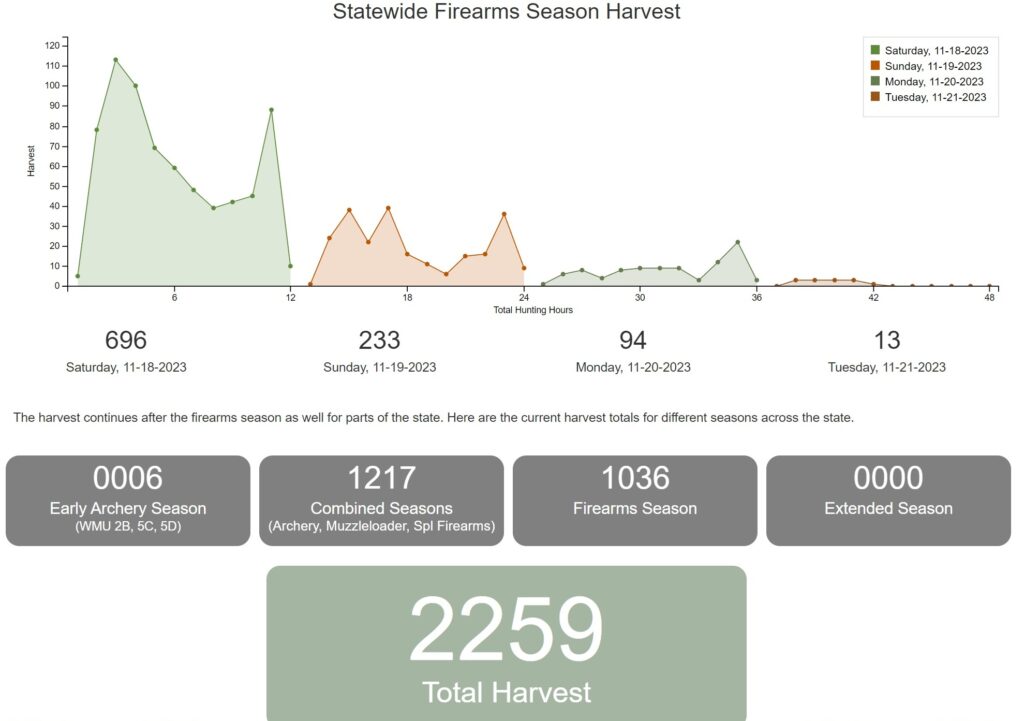
Harvest results as of the last night of regular rifle bear season, 2023. Not final, but not going to change much. The early season was the best season.
Reflections on 2020 bear season
As if by magic or just the batting of an eyelid, the much anticipated 2020 bear season is now behind us, having concluded at dark yesterday. Sad to see our friends go; we had such a fun time! The last of our bear hunting guests have left, cleanup has commenced, preparations are under way for Thanksgiving, and there are some reflections to be had on bear season.
First, where the hell were the bears? Serious question here. We hunt in a mountainous Northcentral area that is Pennsylvania’s “Bear Central.” And despite us daily scouring a lot of remote, very rugged territory that is usually home to lots of bears, we saw neither bears nor bear poop. None. It could be the warm weather has bears hunkered down under cool overhangs in even more remote places. It could be the low acorn crop has bears going in to hibernation early, because there is no more food for them to eat to put on the extra fat they need to hibernate successfully. The truth is, no bear tracks or poops have been seen around here for months, which is remarkable. I cannot think of any year prior like this.
Second, where were all the hunters? We heard only a few shots between Saturday and Sunday, and either none or one on Monday, and for sure none on Tuesday; and very few hunting parties were on the radio on any day. This means that few large scale hunting drives were going on. Without hunters moving across the landscape, the bears don’t have to move out of their way. They can just sit still and not run the risk of exposing their rib cage to a hunter’s bullet. That means that the bears can loaf about in some remote corner, escaping the unseasonable warmth or just waiting for the wafting human scent to drift away before making their usual rounds again. Which means the few hunters who are out don’t see much action.
Third, where were all the other critters, like turkeys and deer? Like with bears, we saw very little deer or turkey poop in the woods. And although I myself saw two whopper bucks and a five-point up close, no one else saw any deer. Nor did any of us see any turkeys. Once again, the absence of these otherwise ubiquitous animals could be due to the relative absence of acorns. Which would push the wildlife far afield to find food sources.
Fourth, despite all of our hunting setbacks, did any of us care a bit? No! We missed all of our friends who could not be with us for various reasons, like fear of the CCP virus, or family emergencies requiring them to stay at home. But those of us who gathered had a lot of fun nonetheless. And with or without a bear on the game pole, we would not have missed this time together for any reason at all. We caught up on our families, our work, our homes, cars, friendships, wives, and politics (yeah, there was a lot of pro-Trump politics). Some people drank way too much alcohol, and we got some great pictures of it all, like the one guy asleep on the cold ground outside. No, we don’t post those here. We ate like kings, that is for sure, and no one lacked for food or drink.
Finally, it is possible that the new early bears seasons (archery, muzzleloader, and special junior+ senior rifle) are removing so many bears from the woods that come rifle season, very few huntable bears remain to be had. According to real-time hunting harvest data posted at the PA Game Commission website, more bears were killed in the early seasons than in the official rifle season this year. This means there are fewer bears available for the rifle hunters. It is possible that many hunters expected this, based on last year’s harvest patterns, and they stayed home or hunted alone, instead of joining the big crew at camp, like usual. As of late today, just 3,138 bears had been killed total this year. That is about a thousand fewer than expected.
Based on this raw data alone, the early bear seasons are actually backfiring. They are not removing the high surplus number of bears that are beyond Pennsylvania’s social carrying capacity. Rather, the early bear seasons are removing the easiest bears and leaving few to be hunted in the later rifle season.
And this new dynamic could be the real story in PA’s bear season: There are so many early season bear hunting opportunities for individuals that they collectively take the wind out of the sails for the regular season hunters, thereby having a boomerang effect on the entire thing and limiting it.
We won’t know what all this data really means for another few years, and by then either great or even fatal damage will have been done to Pennsylvania’s traditional bear camp culture, with its big gatherings and big drives and big camp camaraderie dying out, or we will simply all have to learn to adapt to new ways of hunting. I have to say, there is no substitute for men gathering at a camp to hunt together. The gathered hunting party is the most human of experiences; it is an institution as old as our species. Its purpose was not just making meat, but also social and sociological.
I sure hope these myriad new early bear seasons are not self-defeating, in that they do not kill that traditional bear camp culture by removing its whole purpose ahead of the game. Question for the PGC: What incentive is there to push your body hard through rugged and remote landscapes, destroying your boots, tearing your clothing, and often losing or breaking some of your gear, including damaging your gun, when the animal you are seeking has already been removed?
Below are some photos from one of our trail cameras two years ago. Just days after bear season ended, a bear was caught gloriously and most joyously rubbing its back against a young white pine tree. Almost like a pole dancer. Pretty hot hip shakes there. We haven’t seen a bear anywhere around here since May this year.
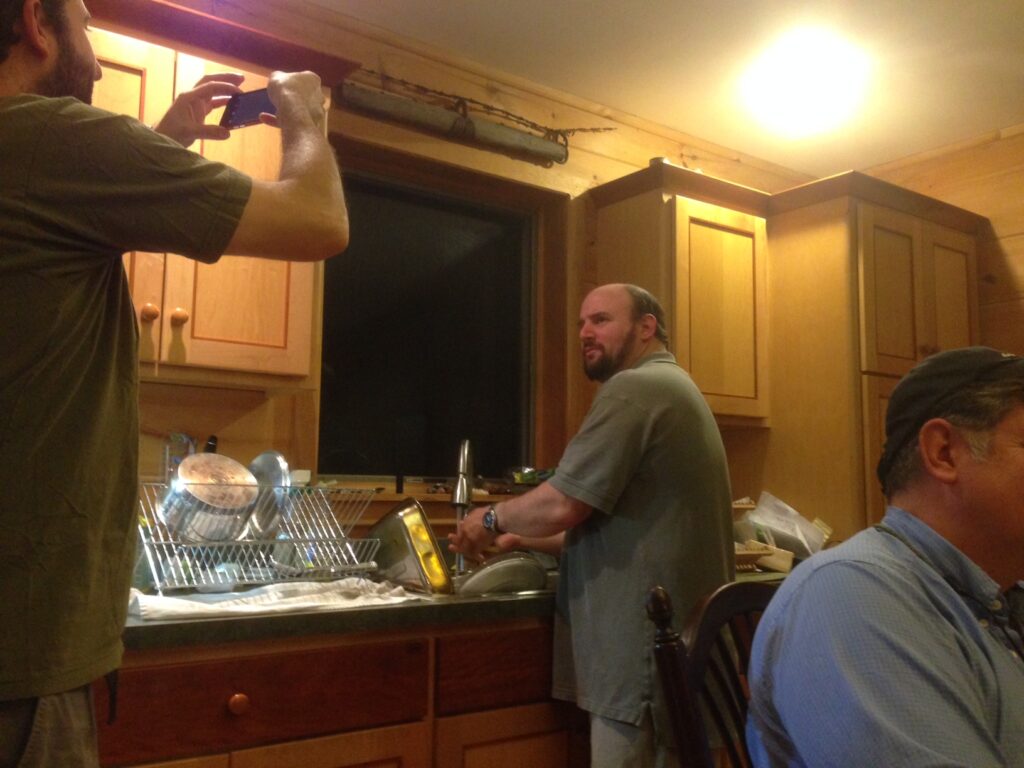
When one of our guys is finally browbeaten into washing dishes after years, it is cause for “Notify the media” acts like taking his unhappy picture. This is back in 2015. He still has to be browbeaten into washing the damned dishes

Lycoming County is the boot-looking shape in the northcentral area. Its northwestern corner is where we hunt. The darkest township there demonstrates the importance of organized hunting drives. A bunch of large hunting clubs are located in this area, and their members put on highly coordinated, obviously successful drives.
It will not hurt to drive slower, but it will definitely help
Are so many of us harried, in a hurry, a bit frayed around the nerves and feeling out of time?
Yes. This frenzied lifestyle is common. It is a sign and way of our time now, where life does not stand still for a second. Smart phones, GPS, email, texting, everything is happening real-time, right now, and we MUST respond and act. We are scheduled by the minute.
Adrenaline junkies like it, and everyone else stays laser focused to the exclusion of much else, goal oriented all the way.
This modern anxious existence is a form on tunnel vision, and it can be witnessed anywhere there is a red traffic light, a stop sign, a pedestrian cross walk, a parking lot, heck even a school pick up zone.
These locations are choke points, places where cars and people tend to gather, and where prevailing traffic must slow down. But a lot of drivers do not slow down in these areas, either because they have tunnel vision or because they are desensitized to congestion. Like everything else, they just plow through it.
Daggone, drivers are in a HURRY to get to that next stop sign, or the next red light. If they would pay attention to the vehicles around them, they’d see that blasting from one light to the next does not advance their cause, but it does eat up their gas and increase the risk of hitting someone.
Parking lots are the biggest buggaboo I see and experience, where drivers just go way too fast. Parking lots are relatively small areas and there is little room for error there. If a driver speeds, driving fast in a parking lot during business hours, there is a real possibility of a pedestrian or two walking through to their car but meeting up with the speedster, instead.
Let us ask some simple questions: Why are we hurrying in these small, tight, confined spaces? What actual time saved are we hoping to bank, a second, two seconds?
What is that miniscule amount of time worth against the life or health of another person, who may be walking nearby? What is our time savings worth when we hurt someone, and then suffer the consequences along with them?
It won’t hurt to slow down. It might even help, because accepting the terrible fate of losing a few seconds of time can become a form of Zen relaxation.
Try it, you will like it.
Downton Abbey’s “field sports” Part II
Guess I shot from the hip, shot first and asked questions later, didn’t identify my target too well, or another euphemism you may enjoy applying to the lack of foresight I brought to yesterday’s analysis of Downton Abbey’s field sports.
Yes, I could have sneaked a peak ahead of the coming scenes, like many other avid watchers of PBS’s hit show do, but because I lack the time and the inclination to sneak anything, I just sat down in my easy chair and watched the show unfold last night without advance knowledge of its content.
My Sunday afternoon essay about the mediocre depiction of the field sports of Downton Abbey was written beforehand.
So, yes, there was a shooting scene last night, or more accurately, some scenes of wing shooting at driven partridge from bona fide shooting butts, using authentic guns and nice clothes, woven in and out of the story about the Scottish castle party.
But once again, there was more focus on the clothes on the people holding the guns than on the Purdeys, Rigbys, and other Best-quality side-by-side shotguns being used to down the birds.
In 1924, $150,000-then-equivalent Purdey shotguns do not get left with the menial help in the kitchen. They are fussed and obsessed over by their owners, kept locked in their rooms, cased with abundant hand-made accoutrements, labeled beautifully by their makers, and often proudly handed down from generation to generation and worn with traditional hunting clothes.
Scottish castles are loaded with arms and armor, and we barely got a peak at the edged weapons welcoming guests through the front door.
The wagons taking the hunters to the field were right, and a nice touch. I have ridden in such wagons on traditional hunts, and they are today an unnecessary throwback. But back then, they were a necessity through muck and muddy moors.
Shooting driven partridge from the butts was mostly done right, with gun loaders ducking to avoid being seen by the birds, and we did see some people bunched up waving white flags, but a real drive could have been filmed for full authenticity. Actual dead birds could have fallen. Smoke could have emitted from the barrels. Etc etc.
Depicting the shooting sports in so briefly and so shallow a manner is the equivalent of dressing Lady Mary in a perfect 1920s top with modern hip-hugger blue jeans below. It is just wrong. Don’t do that!
A lot of non sequiturs occurred last night that really deprive the Downton Abbey audience of a full appreciation of the English field sport lifestyle, which actually reached its pinnacle in the 1920s (when cheap skilled labor was matched with newly superior steel and modern technology to create firearms that even today still command huge sums of money, not to mention the introduction and propagation of Asian pheasants to the English countryside), the time we are watching in the show.
I am sorry to criticize you, Julian Fellowes, because Downton Abbey is otherwise a great show, everything we want it to be.
Last night was disappointing, because the rich details of noble Scottish and English hunting rites should have been indulged. As a student of English history, you are missing a great, even important opportunity here to dig into a meaty subject which your audience will surely enjoy, even if it involves G-U-N-S.
Maybe in January 2016 we will get a more thorough treatment of a subject that may be missing from Mr. Fellowes’ life today, but which was a nearly daily ritual for the actual residents of Downton Abbey and their peers in the 1920s.
Are Turtles Crossing the Road Really a Threat?
Why drivers seem to target slow-moving, non-threatening little turtles is beyond understanding.
Don’t we all have a soft spot in our hearts for innocent, vulnerable, gentle creatures that do us no harm?
The same goes for snakes, which eat the rodent mice, rats, and chipmunks that do so much damage to our homes, crops, gardens, and vehicles.
Every spring and summer, turtles cross roads as they leave water bodies like rivers, ponds, lakes, and marshes, and seek out soft soil where they can lay their eggs, so that the next generation of their kind can continue their unimposing life cycle. Yet every year, roadways are littered with dead and wounded turtles, many dying slowly in the baking hot sun.
Their crime is nothing more than appearing in front of humans behind the wheel of a machine. Are so many of us really so homicidal or sadistic that we go out of our way to hurt, injure, and kill a little helpless animal?
The unfortunate, sad answer is Yes, a lot of drivers go out of their way to hit turtles with their cars. You can simply look at where the turtles lie, crushed or wounded on the side of the road, where the car driver had to actually veer off the roadway to hit the helpless little thing. What is really sad is that turtles take at least ten years to breed, so killing one or two (or stealing one or two) in a given area can doom or kill off the entire population there.
If you have compassion for turtles, you can watch these instructive videos below, where curious turtle-liking guys put a rubber turtle alongside some roads near their homes and generated some unhappy results, and where drivers get out to try and help injured turtles.
Bottom line is Yep, drivers went out of their way to run over the little rubber turtle.
Good luck today, deer hunters
Like many Pennsylvania families today, ours went afield for the morning. My son, having watched an enormous buck run past us in the early morning dark, minutes before shooting light, decided his feet were cold enough and it was time for him to head in.
None in our hunting party got a shot off, yet, but we are gearing up for an afternoon drive, usually productive.
Good luck today, deer hunters! Hunt safely!
